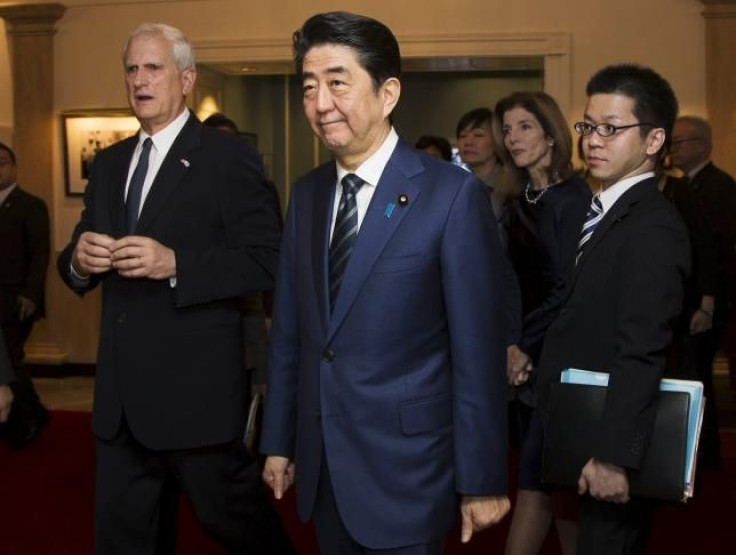US, Japan Unveil New Defense Guidelines For Global Japanese Role

(Reuters) - Japan and the United States unveiled new guidelines for defense cooperation on Monday, reflecting Japan's willingness to take on a more robust international role at a time of growing Chinese power and rising concerns about nuclear-armed North Korea.
Washington told Japanese leaders its commitment to Japan's security remained "iron-clad" and covered all territories under Tokyo's administration, including tiny East China Sea islets that Japan disputes with Beijing.
A centerpiece of Japanese Prime Minster Shinzo Abe's U.S. visit this week for talks with President Barack Obama, the guidelines are part of Abe's wider signal that Japan is ready to take more responsibility for its security as China modernizes its military and flexes its muscles in Asia.
The guidelines allow for global cooperation militarily, ranging from defense against ballistic missile, cyber and space attacks as well as maritime security. They follow a cabinet resolution last year reinterpreting Japan's post-World War Two pacifist constitution.
The resolution allows the exercise of the right to "collective self-defense". That means, for example, that Japan could shoot down missiles heading toward the United States and come to the aid of third countries under attack.
At a joint news conference with Japan's foreign and defense ministers, U.S. Secretary of State John Kerry called the first revision of the guidelines since 1997 "an historic transition".
In a pointed message to Beijing over its increasing assertiveness in Northeast and Southeast Asia, Kerry said the United States rejected any suggestion that freedom of navigation and overflight were "privileges granted by big states to small ones subject to the whim and fancy of the big state".
The guidelines are expected to lead to greater U.S.-Japan coordination in ensuring security in the South China Sea, where China and other regional states have competing claims on scattered islands.
However, at the news conference, Japanese Defense Minister Gen Nakatani and Foreign Minister Fumio Kishida repeatedly dodged questions about the possibility of joint patrolling of Asian sea lanes, saying legislation in Japan had still to be worked out and regional countries consulted.
Kerry made clear Washington was ready to stick to its treaty obligations to Japan, saying: "Our treaty commitment to Japan's security remains iron-clad and covers all territories under Japan's administration".
The guidelines eliminate geographic restrictions that had largely limited joint work to the defense of Japan and the surrounding area, a senior U.S. official said.
"We will be able to do globally what we’ve been able to do in the defense of Japan and regionally," the official said.
Missile Defense
The changes allow greater coordination and information sharing and allow increased cooperation in cybersecurity and defense of assets in space.
While saying the guidelines were "not specifically aimed" at China and highlighting the threat from North Korea, U.S. Defense Secretary Ash Carter told the news conference: “The answer for this region isn’t for anybody to throw their weight around.”
Despite U.S. assurances of its military commitment, worries have persisted in Tokyo that one day Washington, which is reining in defense spending and deeply intertwined economically with China, may not come to Japan's defense.
Patrol ships and military aircraft from rival claimants in the East China and South China Seas routinely shadow each other near contested territory, raising fears that an unintended collision or other incident could develop into a larger clash.
Obama, who meets Abe on Tuesday, has said Japanese-controlled isles are covered by a bilateral security treaty obliging the United States to defend Japan, but Washington has made clear it does not want to get dragged into a Sino-Japanese conflict.
The revisions to the guidelines reflect a profound evolution in Japanese security policy and represent the most dramatic shift since Japan's military was rebuilt after World War Two.
The constitutional reinterpretation still needs to be enabled by legislation later this year, but will also allow Japan's military to take actions such as mine-sweeping during hostilities in the Hormuz Strait in the Gulf and provide logistical support for U.S. forces beyond Japan's immediate neighborhood without a specific law for each operation, Japanese lawmakers and government sources say.
A key Liberal Democratic Party lawmaker said Abe's ruling LDP party also wants to revise Japan's constitution by late 2018 to remove constraints on his defense strategy and avoid time-consuming legal gymnastics over the interpretation of the current charter.
© Copyright Thomson Reuters 2024. All rights reserved.











